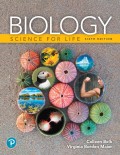
EBK BIOLOGY
6th Edition
ISBN: 8220106777640
Author: Maier
Publisher: PEARSON
expand_more
expand_more
format_list_bulleted
Concept explainers
Question
Chapter 10, Problem 3LTB
Summary Introduction
Introduction:
Every organism is composed of a cell. The process performed by the cell for survival is a cellular process. Translation is an important cellular process that helps in the survival of cell.
Expert Solution & Answer
Want to see the full answer?
Check out a sample textbook solution
Students have asked these similar questions
In protein synthesis, DNA transcription records the genetic message, while ribosomal ______________ interprets the message
______ mutations in the coding sequences of a gene maymodify the amino acid sequence of the polypeptideproduct.?
describe the process of lysosomal hydrolase arriving to the lysosome. without including translation
Knowledge Booster
Learn more about
Need a deep-dive on the concept behind this application? Look no further. Learn more about this topic, biology and related others by exploring similar questions and additional content below.Similar questions
- Indicate in which category, transcription or translation, each of the following functions belongs: RNA poly-merase, ribosomes, nucleotides, tRNA, pre-mRNA, DNA, anticodon, amino acids.arrow_forwardpathway of proteins from the nucleusarrow_forwardWhich of the following describes the sequence of events that occur during protein synthesis? tRNA enters nucleus --> transcription begins --> MRNA moves to cytoplasm > protein synthesis begins splicing of introns --> transcription --> MRNA synthesis translation --> transcription --> splicing of primary MRNA transcript --> translocation of MRNA --> translation translation --> transcription --> MRNA synthesis transcription --> translation --> MRNA productionarrow_forward
- Ubiquitin binds to newly synthesized proteins at the ribosome to assist in the protein folding process. True Or Falsearrow_forwardWhich is NOT a true difference between messenger RNA and DNA? (i.e., which of the following statements is false?) DNA remains in the nucleus (except when the nuclear envelope breaks down during mitosis), whereas mRNA is never in the nucleus; it is always in the cytoplasm. A DNA molecule has a longer life span than a typical molecule of RNA. DNA has thousands of genes; mRNA is usually a copy of just one gene. DNA has thousands of genes; mRNA is usually a copy of just one gene.arrow_forwardCell-cell recognition occurs because _____ is secreted from the cell and is attached to the external phospholipidsarrow_forward
- To be considered a transcription factor, a protein must bind the DNA. True or Falsearrow_forwardTrue/False: The small subunit of a ribosome catalyzes the formation of the peptide bonds that link amino acids together. True Falsearrow_forwardMuscle cells and neurons have the exact same DNA, however, they look very different and perform different functions. Explain why.arrow_forward
- _____________ is a protein meshwork attached to the inner surface of the inner nuclear membrane.arrow_forwardHydrogen bonds are important in DNA replication and transcription. They are relatively weak chemical bonds. Why is this a desirable feature for DNA? Describe the effect (s) of changing (mutating) the promoter on the transcription of the DNA strand/gene the promoter controls. What happens to protein synthesis if a nonsense codon is inserted into the gene? Explain why a point mutation does not necessarily change the original amino acid sequence. (Explain silent mutations) Choose any pentapeptide composed of five different amino acids. List the amino acids. Present one messenger RNA codon for each amino acids and the sequence of nucleotides on the DNA that originally coded for your pentapeptide.arrow_forwardUse the following information to answer the next question. The DNA strand shown below is thought to contain the genetic code for part of an enzyme B-galactosidase which is involved in lactose metabolism. (Read the DNA beginning at the left.) -A-T-A-T-G-G-G-G-C-A-T-G The second amino acid coded from the section of DNA for B-galactosidase is Select one: a. thymine b. tryptophan c. serine d. threoninearrow_forward
arrow_back_ios
SEE MORE QUESTIONS
arrow_forward_ios
Recommended textbooks for you
 Human Heredity: Principles and Issues (MindTap Co...BiologyISBN:9781305251052Author:Michael CummingsPublisher:Cengage Learning
Human Heredity: Principles and Issues (MindTap Co...BiologyISBN:9781305251052Author:Michael CummingsPublisher:Cengage Learning

Human Heredity: Principles and Issues (MindTap Co...
Biology
ISBN:9781305251052
Author:Michael Cummings
Publisher:Cengage Learning


QCE Biology: Introduction to Gene Expression; Author: Atomi;https://www.youtube.com/watch?v=a7hydUtCIJk;License: Standard YouTube License, CC-BY